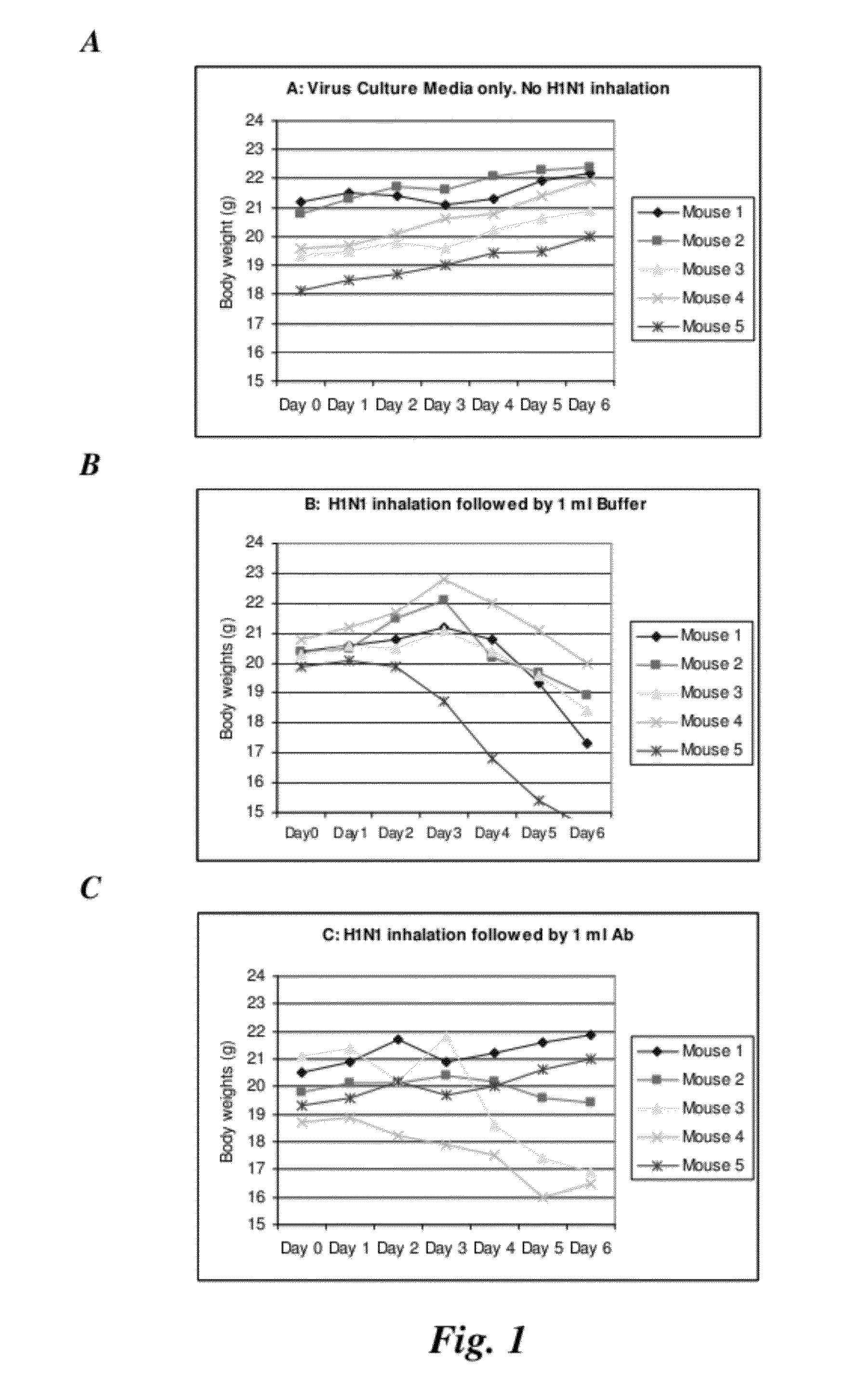Affinity purified human polyclonal antibodies against viral, bacterial and/or fungal infections and methods of making and using the same
a technology of human polyclonal antibodies and affinity purification, applied in the field of immunomodulatory drugs, can solve the problems of ineffective vaccine formulations for one year, pneumonia, and a significant cause of illness and death in clinical and non-clinical settings
- Summary
- Abstract
- Description
- Claims
- Application Information
AI Technical Summary
Benefits of technology
Problems solved by technology
Method used
Image
Examples
example 1
Synthesis and Immobilization of Influenza A Virus Peptides
[0790]Forty nine Influenza A virus (H1N1) peptides having amino acid sequences of SEQ ID NOS: 1-49 were selected from the H1N1 viral components of PB1, PB2, PA, HA, NP, NA, M1, M2, NS1 and NS2. The peptides were synthesized with a cysteine added to the N-terminus as a spacer for immobilization to the solid phase, the CNBr-activated Sepharose 4B (GE Healthcare Bio-Science Corp., Piscataway, N.J.).
[0791]The lyophilized peptides were dissolved in deionized water, pH 3, before addition of the immobilization buffer, 0.05 M borate buffer, pH 8.5, containing 0.5M NaCl. The lyophilized CNBr-activated Sepharose 4B was suspended in 70% ethanol, made in deionized water, pH 3. The Sepharose 4B suspended in the 70% ethanol, pH 3, was incubated at room temperature (RT, 20-25° C.) on an orbital shaker at 75 rpm for gel sanitization. The ethanol was removed by washing the gel in a Büchner glass funnel with deionized water, pH 3.0. The washed...
example 2
Affinity Purification of Human Polyclonal Antibodies from Human Plasma
[0792]Normal human source plasma of injectable grade was obtained from licensed U.S. blood collection centers. The plasma was thawed at room temperature and pooled before fractionation with saturated ammonium sulfate. Briefly, an equal volume of the 100% saturated ammonium sulfate (SAS), made in 0.01M phosphate-buffered saline (PBS), pH 7.4, was added slowly into the pooled plasma at room temperature with stirring. The mixture was stirred and incubated at room temperature for 2 hours before centrifugation at 4,500 rpm in a Beckman centrifuge. The pellets were reconstituted in PBS. Pre-mixed and pre-diluted in PBS solvent / detergent (S / D), Triton X-100 and tri-N-butyl phosphate (TNBP), was added into the reconstituted, fractionated plasma to yield 1% and 0.3% respectively. The plasma was stirred at RT for 4 hours before being buffer exchanged 5 times into PBS.
[0793]The SAS-fractionated, S / D treated human plasma was ...
example 3
Immune Protection Using Affinity Purified Human Polyclonal Antibodies
[0796]Madin-Darby Canine Kidney (MDCK) cells were cultured in Eagles' Minimal Essential Medium, supplemented with 2 mM L-glutamine, 10% fetal bovine serum (non-heat inactivated), 1% non-essential amino acid solution, 0.15% sodium bicarbonate, 1% sodium pyruvate and 1% penicillin / streptomycin. The culture medium was replaced by live H1N1 viral culture 3-5 days after the initial MDCK. culture. The viral culture was continued for 5-7 days until it reached viral confluence by centrifugation at 1,500 rpm for 5 minutes at 2-8° C.
[0797]Fifteen BALB / C mice, 18-20 g body weight, were used in this study. The mice were divided into three experimental groups, five animals each. The animals in Group 1 (control) received intranasal inhalation of 50 μl of culture medium, whereas the animals in Groups 2 and 3 received intranasal inhalation of 50 μl of H1N1 virus. The animals were weighed daily. Three days after the viral inhalatio...
PUM
| Property | Measurement | Unit |
|---|---|---|
| Concentration | aaaaa | aaaaa |
| Concentration | aaaaa | aaaaa |
| Composition | aaaaa | aaaaa |
Abstract
Description
Claims
Application Information
 Login to View More
Login to View More - R&D
- Intellectual Property
- Life Sciences
- Materials
- Tech Scout
- Unparalleled Data Quality
- Higher Quality Content
- 60% Fewer Hallucinations
Browse by: Latest US Patents, China's latest patents, Technical Efficacy Thesaurus, Application Domain, Technology Topic, Popular Technical Reports.
© 2025 PatSnap. All rights reserved.Legal|Privacy policy|Modern Slavery Act Transparency Statement|Sitemap|About US| Contact US: help@patsnap.com

